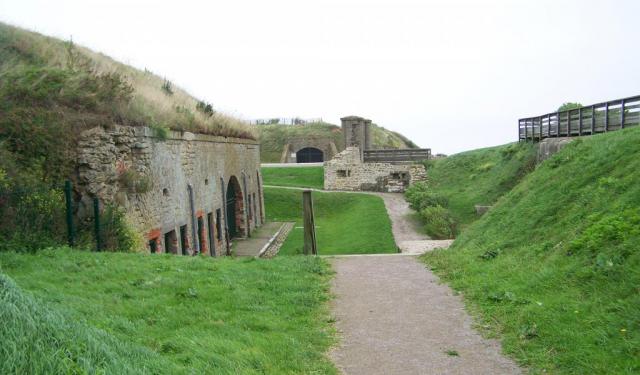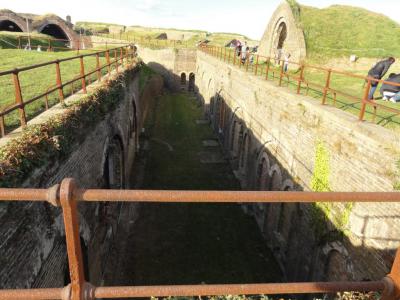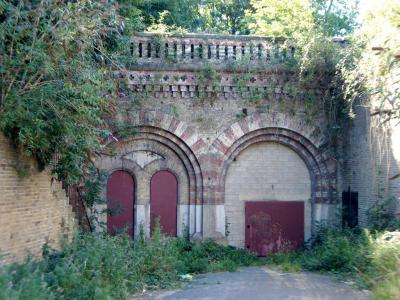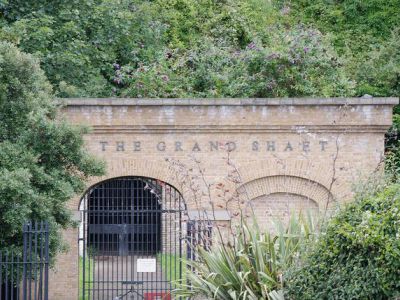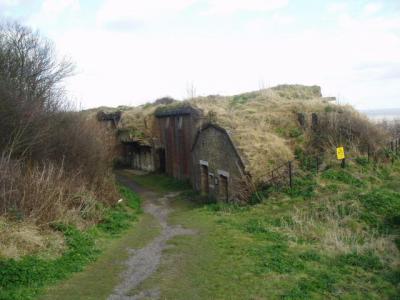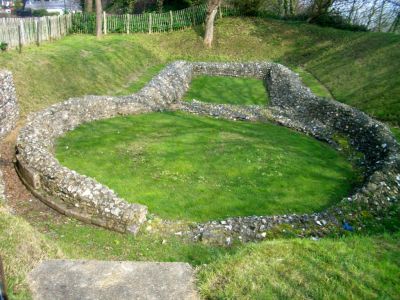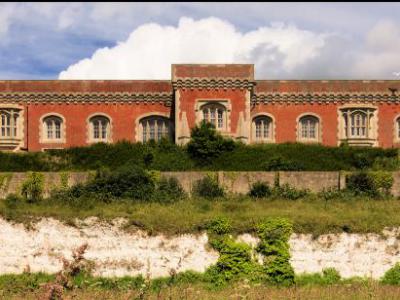Western Heights Walking Tour (Self Guided), Dover
The Western Heights of Dover is an impressive fortification built for protection against invaders. Construction took place at the time of the Napoleonic Wars, with improvements continuing during the 19th century. This immense hilltop fortress features an incredible network of forts, barracks, tunnels, ramparts, and massive ditches.
There are two forts at Western Heights, the Drop Redoubt and the Citadel. The forts were linked together by wide dry ditches strengthened by brick walls for defensive purposes. They offer an intriguing spot for exploration around the fortification.
The Grand Shaft is a vertical passageway that descends from the top of Western Heights down to the town below. It contains a unique triple spiral staircase, the only one in the country. The North Entrance was once the main entrance to the fortification. Entering into a tunnel, it offered access to the fortress for military members and supplies.
St Martin's Battery was built to help improve the coastal defense. This Victorian gun battery sits on a hillside location that offers stunning harbor views. Don't miss the ruins of the Knights Templar Church, located in a quiet area near a residential neighborhood of Western Heights. Historically interesting, though little remains of this ancient structure other than the stone and flint foundation of the chapel.
A walk through the countryside on the pathways and trails around Western Heights offers magnificent views of the harbor and town of Dover. You'll love exploring this fascinating fortification as you experience history on this self-guided walking tour.
There are two forts at Western Heights, the Drop Redoubt and the Citadel. The forts were linked together by wide dry ditches strengthened by brick walls for defensive purposes. They offer an intriguing spot for exploration around the fortification.
The Grand Shaft is a vertical passageway that descends from the top of Western Heights down to the town below. It contains a unique triple spiral staircase, the only one in the country. The North Entrance was once the main entrance to the fortification. Entering into a tunnel, it offered access to the fortress for military members and supplies.
St Martin's Battery was built to help improve the coastal defense. This Victorian gun battery sits on a hillside location that offers stunning harbor views. Don't miss the ruins of the Knights Templar Church, located in a quiet area near a residential neighborhood of Western Heights. Historically interesting, though little remains of this ancient structure other than the stone and flint foundation of the chapel.
A walk through the countryside on the pathways and trails around Western Heights offers magnificent views of the harbor and town of Dover. You'll love exploring this fascinating fortification as you experience history on this self-guided walking tour.
How it works: Download the app "GPSmyCity: Walks in 1K+ Cities" from Apple App Store or Google Play Store to your mobile phone or tablet. The app turns your mobile device into a personal tour guide and its built-in GPS navigation functions guide you from one tour stop to next. The app works offline, so no data plan is needed when traveling abroad.
Western Heights Walking Tour Map
Guide Name: Western Heights Walking Tour
Guide Location: England » Dover (See other walking tours in Dover)
Guide Type: Self-guided Walking Tour (Sightseeing)
# of Attractions: 6
Tour Duration: 1 Hour(s)
Travel Distance: 1.9 Km or 1.2 Miles
Author: jenny
Sight(s) Featured in This Guide:
Guide Location: England » Dover (See other walking tours in Dover)
Guide Type: Self-guided Walking Tour (Sightseeing)
# of Attractions: 6
Tour Duration: 1 Hour(s)
Travel Distance: 1.9 Km or 1.2 Miles
Author: jenny
Sight(s) Featured in This Guide:
- Drop Redoubt
- The North Entrance
- The Grand Shaft
- Coastal Defence (Remains of St Martin's Battery)
- Knights Templar Church
- Dover Citadel
1) Drop Redoubt
Located on Dover's Western Heights, the Drop Redoubt is part of a fortification built to protect Dover from invaders. It is one of two forts on Western Heights; the other fort is the Citadel.
Construction of this fort began during the Napoleonic Wars, between 1804 to 1808. Further works were deemed necessary in 1859 to provide improved defenses after an invasion scare. Surrounding the Drop Redoubt is a deep pentagonal ditch. The fort includes a soldier's barracks, gun rooms, a guardhouse, a jail cell, and officer's quarters with fireplaces.
The ruins of a Roman Pharos, a lighthouse dating from the 2nd century AD, stand at the top of the Redoubt. The remains of the lighthouse foundations are on view in the Victorian-era officer's quarters below. The Bredenstone is a name given to this ruin by the locals.
The Drop Redoubt fort is a remarkable hillside structure. Tours are available to see the interior and learn some of the fascinating stories of this fortification. These tours are held on the third Sunday of each month, from April to September. From the grounds around the area of the fort are some lovely views of Dover Harbour.
Construction of this fort began during the Napoleonic Wars, between 1804 to 1808. Further works were deemed necessary in 1859 to provide improved defenses after an invasion scare. Surrounding the Drop Redoubt is a deep pentagonal ditch. The fort includes a soldier's barracks, gun rooms, a guardhouse, a jail cell, and officer's quarters with fireplaces.
The ruins of a Roman Pharos, a lighthouse dating from the 2nd century AD, stand at the top of the Redoubt. The remains of the lighthouse foundations are on view in the Victorian-era officer's quarters below. The Bredenstone is a name given to this ruin by the locals.
The Drop Redoubt fort is a remarkable hillside structure. Tours are available to see the interior and learn some of the fascinating stories of this fortification. These tours are held on the third Sunday of each month, from April to September. From the grounds around the area of the fort are some lovely views of Dover Harbour.
2) The North Entrance
The North Entrance was the main entrance to the Western Heights fortification. This entrance was close to the town of Dover, making it a convenient point for military access or carrying supplies into the fortress. It dates from the 1860s and features two bridges that cross over ditches leading to a tunnel. A pair of arched doorways are at the outer end of the tunnel.
Inside the tunnel is a staircase leading to three gun rooms. There are also three large water tanks. In the past, they supplied water to the Western Heights barracks. An inner entrance leads to a guardroom, a brick structure accessible from the roadway. Interestingly, the guardroom contains an early type of central heating in the form of a grate with ducts for moving cold and hot air.
This historic landmark is currently in a state of ruin and has been the target of vandalism over the years. Tours are available to explore the inside of the tunnel only once a year during a Western Heights Preservation Society open weekend.
Inside the tunnel is a staircase leading to three gun rooms. There are also three large water tanks. In the past, they supplied water to the Western Heights barracks. An inner entrance leads to a guardroom, a brick structure accessible from the roadway. Interestingly, the guardroom contains an early type of central heating in the form of a grate with ducts for moving cold and hot air.
This historic landmark is currently in a state of ruin and has been the target of vandalism over the years. Tours are available to explore the inside of the tunnel only once a year during a Western Heights Preservation Society open weekend.
3) The Grand Shaft
The Grand Shaft is a unique triple-helix staircase in a tunnel. It descends 140 feet from the top of the Heights to Snargate Street, straight through the White Cliffs of Dover. It was built to offer rapid passage up and down between the barracks of Western Heights and the town.
Construction began in 1806 but was not completed until three years later, bedeviled by bad weather that continually caused the sides to collapse. At this time, Snargate Street was a red-light district with taverns and brothels. A guardhouse and prison cells were built at the entrance to the tunnel. The cells were used to put drunken soldiers in for the night.
After World War II ended, the barracks at Western Heights fell into ruin and, in the 1960s, were torn down. The Grand Shaft was no longer being used and became a place in town for folks to dump their rubbish. Eventually, a restoration took place, and the site became open to the public.
Visits to the Graft Shaft and its staircase are available between March and November, on the third Sunday of the month. It is well worth seeing as the only triple spiral staircase in the country.
Construction began in 1806 but was not completed until three years later, bedeviled by bad weather that continually caused the sides to collapse. At this time, Snargate Street was a red-light district with taverns and brothels. A guardhouse and prison cells were built at the entrance to the tunnel. The cells were used to put drunken soldiers in for the night.
After World War II ended, the barracks at Western Heights fell into ruin and, in the 1960s, were torn down. The Grand Shaft was no longer being used and became a place in town for folks to dump their rubbish. Eventually, a restoration took place, and the site became open to the public.
Visits to the Graft Shaft and its staircase are available between March and November, on the third Sunday of the month. It is well worth seeing as the only triple spiral staircase in the country.
4) Coastal Defence (Remains of St Martin's Battery)
Built during the 1870s, Saint Martin's Battery is on an elevated site that overlooks the harbor of Dover. It sits on a terrace that was artificially cut into the hillside on Western Heights. The construction of this battery was part of an effort to improve the coastal defense.
The structure's design kept low visibility in mind to help keep it hidden from approaching enemy attacks. Artillery mounted in the battery included three large rifled muzzleloaders, the guns invented in the mid-19th century for use in forts and ships. In the early 20th century, Saint Martin's Battery became obsolete and was disarmed.
After a threat of invasion in 1940, during World War II, it was reopened as an emergency battery and renamed "Western Heights Battery." It was extensively remodeled and offered added protection against air attacks. After the war, the site was abandoned. Today, you can visit the outside of the battery and take a walk around the area of this fascinating historical location. You won't want to miss the beautiful harbor views!
The structure's design kept low visibility in mind to help keep it hidden from approaching enemy attacks. Artillery mounted in the battery included three large rifled muzzleloaders, the guns invented in the mid-19th century for use in forts and ships. In the early 20th century, Saint Martin's Battery became obsolete and was disarmed.
After a threat of invasion in 1940, during World War II, it was reopened as an emergency battery and renamed "Western Heights Battery." It was extensively remodeled and offered added protection against air attacks. After the war, the site was abandoned. Today, you can visit the outside of the battery and take a walk around the area of this fascinating historical location. You won't want to miss the beautiful harbor views!
5) Knights Templar Church
The Knights Templar Church once stood on the Western Heights of Dover. Now all that remains is the flint and stone foundation of the church's chapel. Visitors can see the remnants of a small circular nave and a rectangular chancel that were once part of the church. The Knights Templar Church was built during the 12th century. Discovery occurred in the early 19th century during construction work on the Western Heights fortifications.
This church has been linked to the Knights Templar, a religious and military order founded in Jerusalem during the Crusades (a series of religious wars initiated and supported by the Latin Church in the medieval period). The Knights Templar offered protection for pilgrims traveling to the Holy Land. This church is considered to be one of the order's earliest properties.
You'll find the foundations of this ancient church near Citadel Road in a residential neighborhood. Its location offers a tranquil setting in a grassy patch, a quiet spot for a visit to this historical site.
This church has been linked to the Knights Templar, a religious and military order founded in Jerusalem during the Crusades (a series of religious wars initiated and supported by the Latin Church in the medieval period). The Knights Templar offered protection for pilgrims traveling to the Holy Land. This church is considered to be one of the order's earliest properties.
You'll find the foundations of this ancient church near Citadel Road in a residential neighborhood. Its location offers a tranquil setting in a grassy patch, a quiet spot for a visit to this historical site.
6) Dover Citadel
Dover Citadel is part of the impressive Western Heights fortifications. Its origins began during growing threats of the French invasion in the late 18th century. At this time, an improved defense system on the hill was planned. A citadel was to be constructed on the western side and a redoubt on the eastern side, with defensive lines connecting them.
Eventually, two forts were built on Western Heights, the other being the Drop Redoubt. By 1859, after a perceived threat by Napoleon III, enhancements were made to the Citadel to improve the fortification. Strengthening with brick walls was done to the wide defensive ditches. These walls contained positions for guns. New additions to the fortification included a drawbridge, officer's quarters, a guard room, and a gatehouse.
After 1890, the Citadel was mainly used as a military barracks. Since the 1950s, it has served as a prison, an institute for youth offenders, and an immigration removal center.
Eventually, two forts were built on Western Heights, the other being the Drop Redoubt. By 1859, after a perceived threat by Napoleon III, enhancements were made to the Citadel to improve the fortification. Strengthening with brick walls was done to the wide defensive ditches. These walls contained positions for guns. New additions to the fortification included a drawbridge, officer's quarters, a guard room, and a gatehouse.
After 1890, the Citadel was mainly used as a military barracks. Since the 1950s, it has served as a prison, an institute for youth offenders, and an immigration removal center.
Walking Tours in Dover, England
Create Your Own Walk in Dover
Creating your own self-guided walk in Dover is easy and fun. Choose the city attractions that you want to see and a walk route map will be created just for you. You can even set your hotel as the start point of the walk.
Dover Introduction Walking Tour
The lovely coastal town of Dover in Kent, England, overlooking the English Channel from the height of the striking white chalk cliffs, has long been a major sea gate to the country. It is to this iconic landmark, known as the "White Cliffs of Dover", that the isle of Great Britain owes its nickname, the Albion.
According to archaeological findings, this location at the narrowest... view more
Tour Duration: 1 Hour(s)
Travel Distance: 2.8 Km or 1.7 Miles
According to archaeological findings, this location at the narrowest... view more
Tour Duration: 1 Hour(s)
Travel Distance: 2.8 Km or 1.7 Miles
The Most Popular Cities
/ view all
